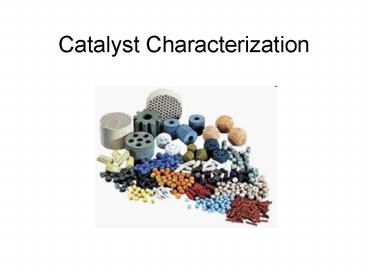Catalyst Characterization PowerPoint PPT Presentation
1 / 41
Title: Catalyst Characterization
1
Catalyst Characterization
2
Reactive gas adsorption
- What can be measured using this technique?
- Who would be interested in such results?
- A brief overview of measurement fundamentals.
- Catalysts
- Instrument specific features of benefit to
analyzing catalysts
3
Reactive Gas Adsorption
- What can be measured using these techniques?
- Amount of reactive sites on a surface
- Active metal area
- Dispersion
- Nanocluster/crystallite size
- Heats of adsorption
- Ease of reduction (TPR)
- Ease of oxidation (TPO)
- Bond strength (TPD)
- Activation Energy
4
Reactive Gas Adsorption
- Who would be interested in such results?
- Catalyst researchers
- Chemists
- Chemical engineers
- Catalyst manufacturers
- Catalyst users
- Catalyst regenerators
5
Reactive Gas Adsorption
- Who would be interested in such results?
- Petrochemical companies
- Catalysts are used to produce higher octane
gasoline - Catalysts are used to produce new products
- New catalysts are needed to utilize biofuels
- Automotive companies
- Catalysts are used to reduce undesirable exhaust
gases - Fuel cell companies
- A fuel cell electrode is a catalyst for combining
two chemicals
6
Petrochemicals/Fine Chemicals
7
- BASF
- Evonik
- Ineos
- Grace Davison
- Haldor Topsoe
- Johnson Matthey
- Interkat
- Bosch
- Chevron
- Criterion
- Delphi
- Engelhard
- Environex
- Exxon Mobil
- Honeywell
- Huntsman
- Hyperion
- Lyondell
- Sabic
- Shell
- Sud-Chemie
- Tricat
- UOP
- W.R. Grace
8
Catalysts
9
Catalysts
- Catalytic Converters Automobile Exhaust
- Catalyst (platinum, palladium and rhodium) on
ceramic or metal support
10
Fuel Cells
11
Active Sites on a Catalyst
- Metal on support.
- Island-like crystallites
- Not all metal atoms exposed.
- Adsorption technique perfectly suited.
- (cf Chemical analysis of entire metal content )
12
Catalysts
- Cracking process catalyzed by a zeolite
micropore structure responsible for
activity/selectivity.
13
Overview of Chemisorption
14
How?
15
Active Site Quantification
- Because the formation of a chemical bond takes
place between an adsorbate molecule and a
localized, or specific, site on the surface of
the adsorbent, the number of active sites on
catalysts can be determined simply by measuring
the quantity of chemisorbed gas
16
Chemisorption
- Static isotherms (manometric system)
- Autosorb-iQ-C (auto)
- Pulse titrations (flowing systems)
- ChemBET (manual)
- ChemBET Pulsar (auto)
- Autosorb-iQ-C-TCD (auto)
17
Preparation Techniques
- Sample is heated under inert flow to remove
adsorbed moisture. While the reduction step
creates moisture, we dont want the reducing gas
to compete for diffusion to surface. - Reduce with H2 can be pure hydrogen or diluted
with nitrogen or argon. Higher concentrations
give higher space velocities for the same
volumetric flow rate. - Purge hot!
18
Setup
Filler rod goes here
Quartz wool
sample
capillary
19
Static (manometric) Setup
adsorptives
manifold
Turbo-molecular (drag) pump
vent
Flow U cell
diaphragm pump
furnace
20
Vacuum Chemi Autosorb iQ-C
21
Extrapolation Method
First (only?)isotherm
22
The Second Isotherm
combined
Volume Adsorbed
Weak only
Pressure (mm Hg)
23
The Difference Isotherm
combined
Weak only
Volume Adsorbed
Strong
Pressure (mm Hg)
24
Principles of Calculation
Monolayer Volume, Vm volume of gas chemisorbed
in a monomolecular layer
25
Metal Dispersion
26
Flow Chemisoroption
27
Flow Types of Analysis
A flow system permits multi-functional catalyst
characterization
active sites
support
28
(No Transcript)
29
(No Transcript)
30
Temperature Programmed
31
Catalysts
- Support Zeolites
- Framework formed, Si O (tetrahedral
arrangement) - Network of cages, cavities, channels
- Responsible for catalytic activity.
32
Catalysts
- Characterization of Catalysts NH3 TPD for Acid
Site Determination
33
Flow Chemi Autosorb iQ-C with TCD OR Pulsar
34
Flow Chemi, Setup (Pulsar)
35
He
N2
36
Titration
LOAD
INJECT
signal
injections
37
Surface Reaction by MS(linear Mass Spec. scale)
TCD signal
38
Surface Reaction by MS(linear Mass Spec. scale)
TCD signal
39
Flow Chemisorption Overview
40
What to Measure?
Property Static Flow AS-iQ-TCD
Multi-point BET surface area -
Single-point BET surface area
Mesopore size distribution -
Micropore size distribution -
Physisorption enthalpy (isosteric heat) -
Vapor sorption isotherm (ads/des) -
Total (combined) chemisorption -
Strong (irreversible) chemisorption
Weak (reversible) chemisorption -
Metal (active) area
Nanocluster (crystallite) size
Catalyst dispersion (based on strong chemi only)
Effective dispersion including spillover -
Chemisorption enthalpy (isosteric heat) -
Activation energy (Kissinger/Redhead) -
Temperature programmed reduction (TPR) -
Temperature programmed oxidation (TPO) -
Temperature programmed desorption (TPD) -
Temperature programmed reaction (TPSR) -
Acid site strength (relative distribution) -
Fulfillment 60 55 100
41
Which Instrument Offers What?
QC ChemBET QC Pulsar QCiQ-C QCiQ-CTCD
Flow(TCD incl) ? ? - ?
Static - - ? ?
Full Physi - - ? ?
Furnace maximum 1100 1100 1100 1100
Furnace cooling - ? ? ?
Loop injection Manual Auto - Auto(option)
Massflowcontroller External option External option Internal option External option

